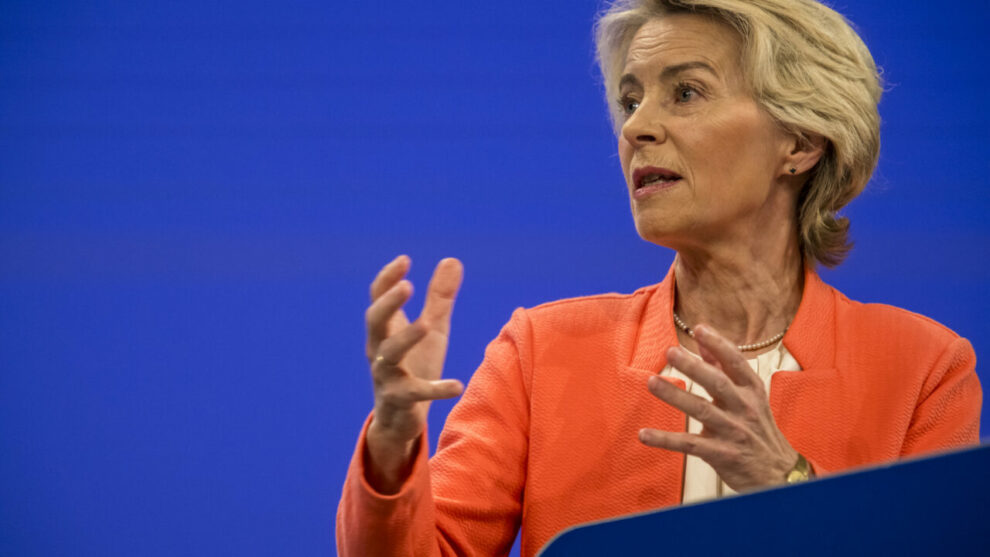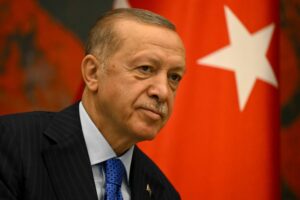European Commission president Ursula von der Leyen has just scored an important victory. From next week, the European Union will impose of tariffs on Chinese electric vehicles for the next five years. Von der Leyen is not like Trump – a fan of slinging tariffs on friends and foes alike – but she is determined to adjust the European Union’s approach to China to fit a new reality. And she has rallied the collective power of the Brussels bureaucracy to deliver.
The tariff decision was a make-or-break moment for von der Leyen’s policy agenda. Now that it has passed, electric vehicles are just the beginning. A range of other investigations, from subsidies for wind turbines to public procurement of medical devices and the misconduct of Chinese fast-fashion giants, are still under way. A creative set of new tools is making a more confident European approach possible.
For once, the story is not about how divided member states are in their relations with China – they always will be. The real story is that at this crucial juncture it didn’t matter
For once, the story is not about how divided member states are in their relations with China – they always will be. The real story is that at this crucial juncture it didn’t matter. With a clear set of goals, the commission president faced no coalition of member states strong enough to oppose the proposed measures. The commission has quietly started a serious recalibration of EU-China relations – and Beijing isn’t happy. The move shows that Brussels has learnt three key lessons on dealing with China. Now the bloc needs to learn how to respond to the backlash.
1. Use new tools, not new rules
The first lesson was to not change the rules but find better ways to apply existing principles. Commission officials were tasked to investigate and address the distortions created by battery electric vehicles from China in the European market. Their assumption was that the low prices of Chinese-produced vehicles are the result of illegal, unfair, and untransparent subsidies and that this causes harm to European producers. While the market share of European car companies in China is plummeting, Chinese market share in Europe’s electric vehicle sector is rising. Things are changing fast and not in European producers’ favour.
In comparison to measures from the United States, the countervailing duties are specific, nuanced, and staggered. But they will still hurt. Chinese car manufacturers, while theoretically able to absorb the additional tariffs, have a huge incentive to export to places that yield higher margins. Making profits elsewhere increases their chances for survival within the Chinese market’s fierce low-margin competition. The tariffs also send an important political signal: the EU will attach a price to doing business and it is ready to create leverage for negotiations.
2. Don’t shy away from difficult sectors
Second, any investigation into the automotive sector was going to create a high degree of tension with and within member states, but Brussels learnt there is value in not shying away. In Europe, car companies are a huge employer and have always been considered a strategic industry. There is an overall dependence on large, mainly German, industry giants, many of which depend on the Chinese market for their profits and have moved production and research and development in the electric vehicle sector to China. These giants are against the tariffs. That’s why the debate was so heated and why there was not a huge group of member states rallying behind the commission. European capitals were conflicted about what they wanted and what they should want. The German government was particularly angered by the investigation, seeing it as harmful for German car companies and their close ties to the Chinese market.
By taking on cars, the commission signalled that Brussels is not only willing but able to act on the tough questions – even without Germany onside. This has created momentum for the slew of measures coming up in the next few months – be it on wind turbines, fast fashion or electrolysers – while Brussels will continue to keep a close eye on sectors like rail rolling stock or solar where just the threat of subsidy investigations has already led to withdrawals of Chinese companies from bids and projects.
3. Withstand Chinese pressure
Third, the EU knew that Beijing would understand how consequential the tariffs would be in their political message – and that the Chinese leadership would try to push back hard. The electric vehicle tariff case was a masterpiece in watching Beijing’s attempts to wield political influence. Seemingly in an attempt to push up “no” votes, the Chinese leadership made vague promises of investments in the troubled auto industry in select member states coupled with targeted threats to key exports from certain EU countries. Beijing also sent multiple high-level delegations to Brussels and key member states.
But in the end, there was little Beijing could offer. Chinese market access for European companies is not going to improve significantly. Uncertainty and regulatory barriers have made market conditions worse, and European market shares in the country will continue to shrink. In the past, Beijing’s sticks and carrots, divide and rule approach regularly worked in its favour, but not this time. The commission faced Berlin down, and in doing so, put Beijing on the backfoot.
Beijing’s bated backlash
Because Beijing needs access to advanced industrial markets for its products, it is unlikely that the Chinese leadership will now roll over and accept defeat. Absorbing tariffs and trying to destroy competition with even lower prices is one option, but Brussels has put Chinese producers on notice, and more regulation is on its way. The debate around the security of connected vehicles, for example, has already begun.
In responding to the EU, tactical adjustments are necessary for Zhongnanhai. Investing in the clean technology sector is central to Beijing’s plan to stimulate growth – some estimates suggest that clean energy technologies, including electric vehicles, have contributed 2 percentage points to China’s 5.4 per cent GDP growth last year. It is a strategic sector in Chinese leader Xi Jinping’s economic vision to strengthen supply chain independence and enhance other countries’ dependency on China. So far, Xi is succeeding – the country dominates in every step of the production process of critical technologies. Low levels of domestic consumption coupled with state-incentivized excess production means Chinese companies must export surpluses to sustain economic growth.
The most immediately obvious option for China to avoid tariffs, address security concerns, and increase political support for cooperation would be for Chinese companies to invest in manufacturing in the EU. But even that is not entirely straightforward. The Chinese domestic ecosystem has been optimised for low-cost and high efficiency and is more resilient to global shocks as the supply chains are highly localised. The economic rationale for Chinese companies to produce in the EU (or for European companies not to outsource production to China) only exists if the bloc maintains high tariffs and regulatory standards in the long term which make production in China for the European market unattractive.
While the economic incentive for Chinese companies to set up production in Europe is questionable, the Chinese leadership might see a political benefit. Creating jobs and being part of the European manufacturing ecosystem generates leverage over local politicians and, depending on the size of the investment, on member state governments. If Dongfeng, a Chinese state-owned car manufacturer, were to become a major employer and taxpayer in Italy, for example, it would have increased lobbying power.
Whether this combination of economic and political incentive is attractive enough for Chinese companies to relocate to the EU at larger scale remains to be seen. The Chinese leadership has voiced concerns about technology transfers and moving key parts of the supply chain out of China, both of which would be required to increase value-added production on EU soil. If the EU mandated such an increase as a precondition to avoid tariffs as trade Commissioner Dombrovskis has indicated, plans of significant Chinese production in the EU would be dead in the water. Chinese company Chery has already announced a delay for its planned production in Spain.
To push back against Brussels, Beijing therefore has two options. It could start a full-on trade war – by increasing tariffs on European imports or by restricting exports of critical goods to select European countries – and see whether this can force member states to oppose Brussels’s plans of further measures. Alternatively, it could embed itself deeper in Europe’s industrial ecosystem, seek compromise, and adhere to data localisation, local content, and financial transparency requirements. The latter is politically unlikely, while the former may be too costly given China’s tottering economy – if member states back Brussels and call Beijing’s bluff.









